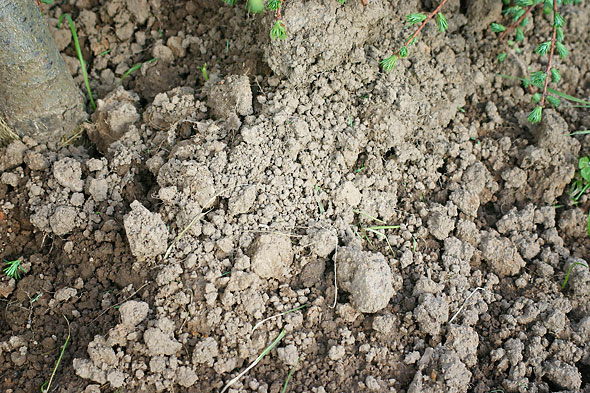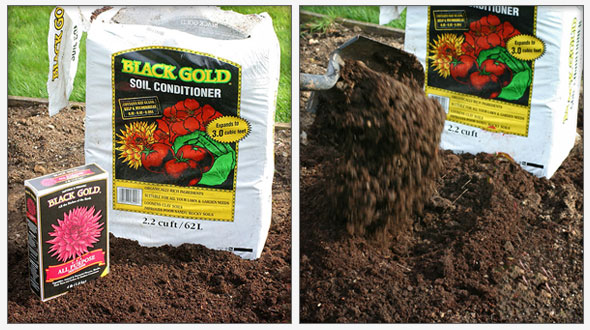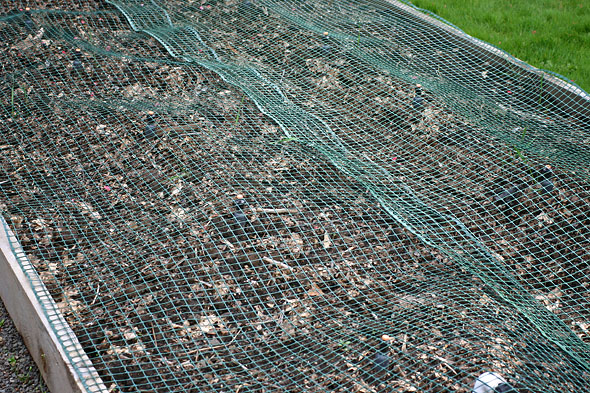In previous articles, I have mentioned the importance of soil preparation before setting out transplants or sowing directly from seed. Prior to planting is the one opportunity to thoroughly prepare the soil. How you amend the soil now is the way it will be for the balance of the season.
have mentioned the importance of soil preparation before setting out transplants or sowing directly from seed. Prior to planting is the one opportunity to thoroughly prepare the soil. How you amend the soil now is the way it will be for the balance of the season.
Many soils in our area, without preparation, will look like the soil you see in the photo on the left. This is the kind of soil that quickly dries out in the summer and can often make a crust over the existing soil and will prevent water from penetrating and causing plants to stress. Sometimes in my garden, I have seen plants wilting in the summer sun and yet I had recently watered them. Upon further observation and some digging around the plant with a trowel, I discover that below the crusty surface the soil is dry.
With the addition of Black Gold Soil Conditioner, it is amazing how quickly the soil can change for the better. I like to spread soil conditioner over the top of the soil and then mix it in with the existing garden soil. If there are large clumps of soil, I try to break them into smaller pieces and work them into the mix, always watching for rocks which I remove. This is a very simple process and as long as the soil is not too wet, it is easy to mix soil and compost or mulch. With our cold and wet spring, many soils are too wet early to adequately dig early in the season, but I have found that after just a few days of sunny weather the soil will become dry enough to cultivate.
I like to have a box of fertilizer close at hand and work this into the soil along with the soil conditioner. A high-performing organic fertilizer formulated for general gardening is your best choice. Incorporate it into the soil before planting.
To get a head start on planting, many gardeners will make or buy a miniature hoop house. This is simply a structure to get the soil warm sooner and provide some protection from the elements. Often gardeners will build a hoop house over a raised bed as the following photos show. The hoop house shown below in this Portland, Oregon garden, has allowed this gardener to start his season earlier in the spring and extend it longer into the fall. The soil preparation is the same as was mentioned earlier. If you are going to sow seeds directly into the ground, the protection a simple hoop house will provide, in many cases, will give you greater success. Even if you are going to use the hoop house to start seeds in flats or small pots, you will have quicker germination and the plants will continue to grow faster than if they were outside with no protection.
With just this plastic protection, it is surprising how much warmer the soil will be and how quickly seeds germinate. In fact, quite often on sunny days, the cover will need to be removed as the temperatures inside will become too hot. An easy way to do this is make a handle to lift the structure. Being able to either open or remove the top is necessary not only to keep the inside from getting too hot but also to provide some air circulation.
To prevent the top from sliding off the sides of the raised beds, this gardener came up with a clever idea. He made two elongated corner braces so the top could be easily lifted and yet would not slide off.
If you are going to sow seeds directly in the ground, it is sometimes beneficial to place something over the top of the soil to discourage birds and squirrels from eating young tender plants. This gardener used this heavy plastic mesh (see photo below), chicken wire also works well.
Here in the Pacific Northwest, slugs can be a huge problem and it is advisable to use some kind of bait or barrier to protect new germinating plants or transplants.
Once your soil is prepped, you are ready. For a novice or first time gardener, if you are going to sow seeds directly into the soil, I would suggest starting your first year with some of those seeds that are relatively easy to germinate. Early spring try seeds like peas, lettuce, kale, radish, and chard. Once summer is here and temperatures are warm, beans, squash, pumpkins, lettuce, and corn are often directly sown in the garden.
It is not difficult to prepare your soil and, with a little bit of work early in the season, your plants will thank you throughout the growing season for your extra effort.
All photos courtesy of Rich Baer.






